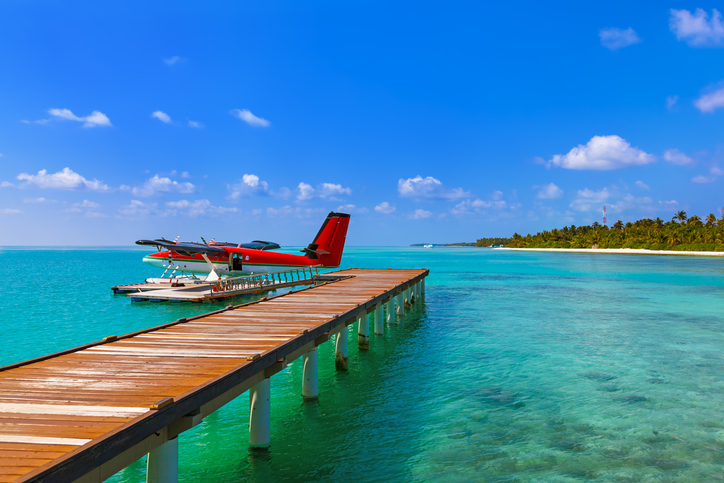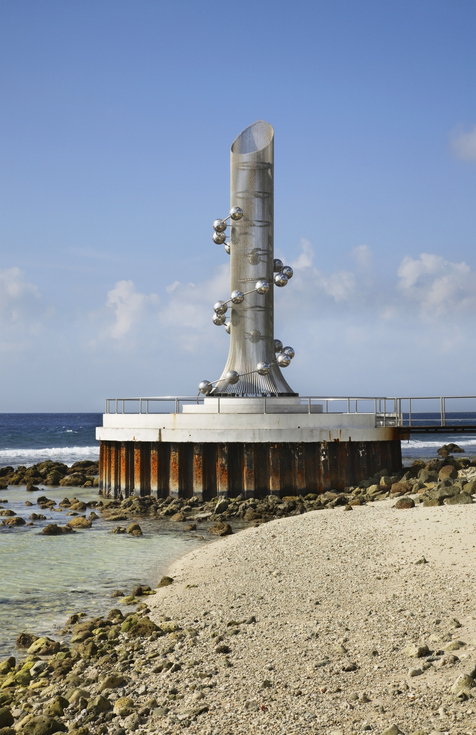Officially called the Republic of Maldives, Maldives Island is a small archipelagic island country in South Asia. It is situated in the Arabian Sea, of the Indian Ocean, and is known for its striking blue waters, alabaster white sand beaches, and spectacular sunsets dipping into the horizon. Spanning across the equator, the country comprises 1,192 islands that stretch along a length of 871 kilometres. Maldives’ unique geography which contains colourful reefs, tiny jewel-like islands rimmed with white gold sand, and clear azure water mesmerize every visiting tourist. Out of its many islands, only 200 are inhabited, and a select few atolls are taken over by private resorts.
Due to its geographical location, Maldives island’s weather is hot and sunny all year round, with average temperatures of 23ºC-31ºC. The best time to visit Maldives is from November to April. A favourite among honeymooners, the Maldives is also home to about five percent of the planet’s reefs.
How To Travel To The Maldives?
Air
Taking a flight to the Maldives is the only practical option for those planning to travel to the country. Most visitors arrive by plane through Male International Airport (MLE), located on Hulhulé Island right next to the capital city Malé. Male Airport sees many flights to and from Sri Lanka, Dubai, China, India, and other major airports in South-East Asia. It also sees many charters from Europe. The Gan Airport in Addu City also serves an international flight to Colombo.
Sea
You will not find any regular passenger boats to the Maldives.
How To Commute Within The Maldives?
There are four main ways of getting around in the Maldives: domestic flights, boats, seaplanes, or private yachts. You will notice how boats are the Maldivian equivalent of a car, while seaplanes and private yachts are mainly reserved for tourists. The domestic airports are Hanimaadhoo Airport, Kaadedhdhoo Airport, and Kadhdhoo Airport.

Usually, seaplanes are preferred when you are in a hurry. Also, as seaplanes fly at a low altitude, they offer breathtaking bird’s eye views of the reefs and islands. However, they have a couple of downsides—they don’t operate at night and your luggage may need to go separately if you are taking a seaplane.
Public ferries are the cheapest option when it comes to commuting between various islands in the Maldives but they take more time and are bound to schedules.
The yacht is the best mode of local transport in the country for a comfortable and luxurious experience. It provides access to isolated reefs and remote islands with the freedom of outdoor life at sea.
Natural Things To Experience:

Fua Mulaku: Known as the largest island in the Maldives, Fua Mulaku is located in the southern province of the Maldivian archipelago. It is a must-visit destination in Maldives island because of its serene seashore, crystal clear water, and water sports activities like boating and snorkelling.
HP Reef: Located in North Male, HP Reef is one of the most beautiful diving spots on Maldives Island. It offers a plethora of brightly coloured corals and is therefore also called Girifushi Thila and Rainbow Reef.
Banana Reef: An ultimate diving destination for diving enthusiasts of all levels, Banana Reef lies underwater between the isles of the North Male Atoll. It is so called because of its unique banana-like shape and houses some of the most exotic and spectacular marine life in the Maldives.
Fish Head: Situated in North Ari Atoll, Fish Head is one of the world’s most famous dive sites. It is also known as Mushimasmingili Reef and is protected by the Maldivian government. Here, anchoring, fishing, or collecting shells or coral are not allowed.
Addu Nature Park: Encompassing the beautiful Eydhigali Kilhi wetlands and protected Koattey area in Hithadhoo Island, Addo Nature Park is home to abundant flora and fauna. You can explore mangroves and lagoons on guided canoe tours.
Man-made Things To Experience:

Tsunami Monument: This steel memorial on the southeastern part of Male city, was constructed in remembrance of the lives lost in the devastating tsunami in 2004. A spiralling monument, it consists of a small cylinder encircling 20 spheres, symbolising the atolls of the country, while the rising pillars stand for the waves of the tsunami.
National Museum: The first National Museum of the country is located at Sultan Park in Male and used to be a part of the site of the 17th-century Maldivian Royal Palace compound. Today, this three-storey museum holds a large collection of unique artefacts that trace the history of Maldives Island as far back as the 11th century.
Grand Friday Mosque: Known for its towering golden dome, the Grand Friday Mosque is one of the biggest mosques in the world. The mosque is part of the Islamic Centre and can house up to 5000 worshippers at a time.
Cultural Things To Experience:
Majidhee Magu: Located in Male, Majhidee is the most famous street market on the island. Crossing the city from the east to the west, it has shops that have anything and everything—from garments, accessories, and cosmetics to handlooms, jewellery, and even electronic items.
The Presidential Palace: Also known as Mulee’age, the palace is situated right opposite the Hukuru Miskiiy, in the capital city of Male. Today, it acts as the residence of the President of the Maldivian Republic and has been home to four presidents till now.
Boduberu shows: A music show to display the “music of Maldives” is set up and performed on multiple occasions. Around 15-20 people wearing a sarong and white shirts move to rhythmic drum beats.
Isdhoo Buddhist Stupas: Located at the northernmost tip of the Atoll, the Isdhoo Buddhist Stupas are filled with the ruins of Buddhist stupas. It traces the history of Buddhism on the Maldives island.
Seasonal Things To Experience:
National Day: National Day marks the great victory of Mohamed Thakurufaanu (Sultan of the Maldives Islands) over the Portuguese in 1573. It is celebrated on the first day of the Rabee-ul Awwal (third month) of the Islamic calendar and is marked by military parades as well as political speeches.
The Day Maldives Embraced Islam: A festival of religious unity, The Day Maldives Embraced Islam is celebrated on the 1st day of the month of Rabi al-Thani (4th month) in the Islamic calendar. Celebratory activities involve lectures, speeches and religious ceremonies about the history of Islamic conversion.
Ramadan: Celebrated on the ninth month of the Islamic or the lunar calendar, Ramadan is one of the most important festivals in the Maldives island. Delicious traditional food is prepared and working hours (of private and government offices) are altered. Special Ramadan juices in exotic flavours of rose and apricot are also prepared.
Bodu Eid: Also called Eid ul Adha, Bodu Eid takes place after the Hajj (annual Islamic pilgrimage to the holy city of Mecca). A tradition unique to the Maldives is that islanders and fishermen weave a big fish using palm leaves during this festival.
Prophet’s Birthday: Also called Mawlid al-Nabi al-Sharif, the Prophet’s birthday is the observance of the birthday of the Islamic prophet Muhammad. It is celebrated on the 12th day of Rabee-ul Awwal (third month) in the Islamic Calendar. Families invite one another to their homes to share special dishes. Many carnivals are organised, as well as large street processions and all the mosques are decorated.
Unique Things To Experience
Maldives’ Victory: This is a famed wreck diving spot that is situated between the gorgeous islands of Male and Hulhule. Maldives Victory used to be a cargo ship, which drove up to a reef in the North Male Atoll in 1981 and sank. Today, the site is a marine reserve and boasts a wonderful marvel of nature, where a plethora of marine life has made their homes.
Bioluminescent Beach: Found on Vaadhoo Island, this beach in Raa Atoll will mesmerise you with its glow-in-the-dark waves. It is caused by micro-organisms called phytoplankton/plankton that radiate a vibrant blue light undersea.
Also Read: Some Glow In The Dark Locations For You To Explore Bioluminescence
Lankan Manta Point: Located in North Male, on Lankanfinolhu Island’s southeast outer reef Lankan Manta Point is a seasonal dive site. You’ll find manta rays at a depth of 10-18 meters at a large block of coral during the southwest monsoons. If you are lucky enough, you might also encounter whitetip sharks, lobsters, and hump head wrasses.
So, When Are You Booking Your Maldives Tour?
The best way to travel responsibly, ethically, and sustainably is by leaving no trace—it is imperative that you save Maldives island by not littering and avoiding using plastic bags. Secondly, practice ‘responsible wildlife watching’. You will be exploring Maldives’ stunning marine life and while doing so, maintain a distance from animals and avoid touching them. While dolphin watching, ensure your tour operator follows speed and distance regulations. Please don’t harass or harm the pods of dolphins when you go dolphin watching.
While Maldives island is equated with luxury, it is still a struggling nation in terms of economy. Try and stay at resorts that hire and train local staff, and are dedicated to sustainability and self-sufficiency. Support the local culture and art by purchasing locally made products, observing cultural performances, and even participating in special experiences. Take a look at the official Maldives tourism website for more information about any restrictions and exclusions for travelling during COVID-19.
Beach lovers will simply love a Maldives tour! So, what are you waiting for? See if the list above can help your planning.
Also Read: Discovering The Maldives: A Blue Paradise


